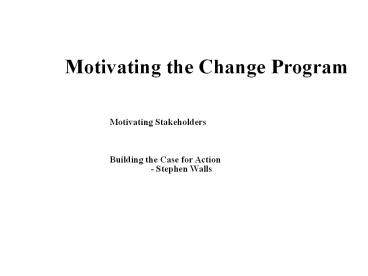Motivating Stakeholders - PowerPoint PPT Presentation
1 / 14
Title:
Motivating Stakeholders
Description:
change management's outcomes and success are nonvisible ... rampant and rarely managed. the case for change is not a statement of action ... – PowerPoint PPT presentation
Number of Views:199
Avg rating:3.0/5.0
Title: Motivating Stakeholders
1
Motivating the Change Program
Motivating Stakeholders
Building the Case for Action
- Stephen Walls
2
Challenges
change management's outcomes and success are
nonvisible or nonquantified for much of the
project - reluctance to budget time for change
management people comprehend change very
narrowly they usually can think of change in
only one change lever (e.g., technology,
structure, culture, organization) people often
misunderstand the scope of the change
(function of their organizational universe)
people at different levels and functions resist
change for very different reasons
3
people cannot visualize the change use pilots,
role playing and simulation people don't
trust the communication rumors are rampant
and rarely managed the case for change is not
a statement of action for change strategists
and implementors, rather it is for change
recipients why they should want to receive the
change each audience needs its tailored case
for action external benchmarking provide as
much disincentive as incentive to a change
program
4
least communication about the case for change
occurs when it is most needed during
transition the senior management does not walk
the talk the market conditions change and the
case for change is not refreshed consultants
deliver the case for change - fatal error nearly
every time
5
Change management takes aminimum of 50 of
projectteam's time
6
The Tale of Frog
If you put a frog in a pot of boiling water,
the shock is so great it will immediately jump
out. However, if you put the frog in a pot of
cool water and raise the temperature
gradually, the frog will accept its
circumstances and eventually expire as the water
rises to the boiling point.
7
Stakeholder AnalysisAssess the Support/
Resistance to Change
perceived threat to job security loss of
expertise need to learn new skills shifts in
influence, authority, control shifts in
communication patterns loss of social status
change in habits/customs limited understanding
of the change and its implications low general
tolerance for change
8
Motivating your StakeholdersOverall
1. form and share the vision for change outside
and inside the organization 2. demonstrate
the vision as much as possible 3. invite broad
participation in a change program 4. analyze
your stakeholder population understand their
motivation for change and their resistance ---
remember you need to keep communicating the case
for action throughout the project, not just
in the beginning
9
Motivating StakeholdersSpecifics
Identify and understand the stakeholders -
the ability to "role-play" stakeholders is a key
skill of a change agent - How
will this affect me? - What do I
think of the change agents? - What
will it take to change my views? -
How will my views change during the project?
Spend lots of time with stakeholders - focus
groups, personal interactions
10
Continually update the stakeholder maps A)
build maps x axis support for changes
y axis impact of contemplated changes
- spend the time with upper left, not upper
right quartile people B)
summarize stakeholder positions -
identify the stakeholder constituency
- identify target and customer groups
- analyze groups on i)
intellectual commitment ii)
emotional commitment iii) required
skills C) identify each stakeholders issues
and develop a plan to address each of
the issues
11
Measure Readiness of EachStakeholder
- Awareness - Self-concern - Mental tryout -
Hands-on - Acceptance
12
What to Do When LoseMomentum
Be candid Inject a customer into the
process Use the voice of employees to bring
reality to the organizational problems and
contemplated solutions Kill something in
public ---- on any project, plan for a day you
lose momentum
13
Change Models
- Outcome of IT Change
- Localized exploitation
- Internal integration
- Business process redesign
- Business network redesign
- Business scope redefinition
- Process of Change
- Tuning
- Adaptation
- Reorientation
- Recreation
Revolutionary
Evolutionary
Anti-cipation
Tuning
Reorientation
Re- active
Recreation
Adaptation
14
Different type of change requires different
types of change management
High
Depth/ Intensity of change
Executive-Led Change
Change through delegation transition management
Change through normal mgmt process
Low
Complexity of change
High
Low































